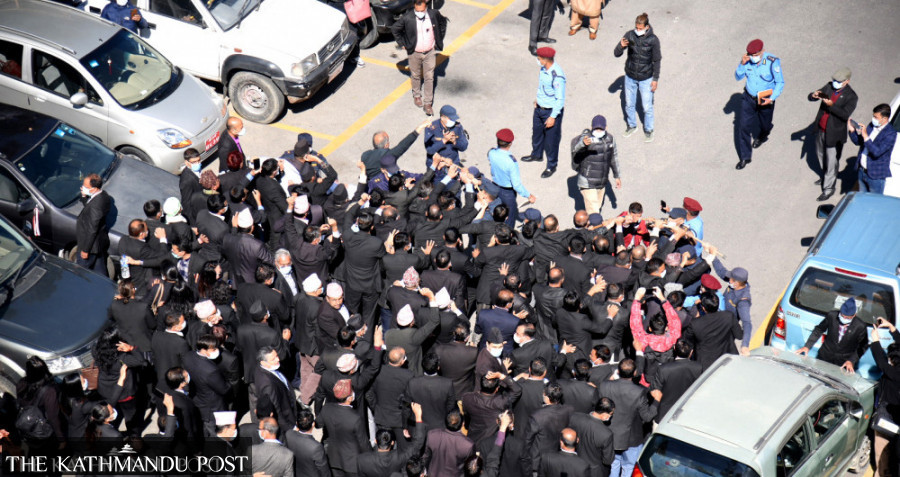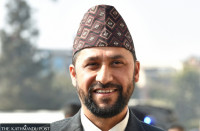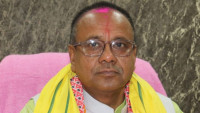National
Lawyers ratchet up protest. Judges in bid to find a middle path out of court row
With Chief Justice Rana refusing to relent, justices are under pressure as hearings have been affected for three weeks. Nepal Bar calls on judges to not hear cases.
Tika R Pradhan
When Nepal Supreme Court justices launched their protest on October 25 demanding reforms in the judiciary, they appeared to be pretty confident that it was a matter of days before Chief Justice Cholendra Shumsher Rana resigned. As the Supreme Court Bar Association and Nepal Bar Association also upped the ante, Rana was gradually being driven into a corner.
But political parties’ failure to take any position—it’s the parties that can file a motion to impeach the chief justice—suddenly emboldened Rana. Now he has not only refused to budge but also put the justices in a moral bind. Despite an agreement that he would not assign any cases except for habeas corpus petitions, Rana started allocating benches starting Tuesday. On Sunday too, Rana assigned as many as 272 cases to various justices.
“The way the situation has unfolded has stuck in our throats,” a justice told the Post. “Actually, we had not imagined that the chief justice would refuse to step down despite suffering so much humiliation.”
According to the justice, it would be difficult for justices to boycott benches for long, as the public has been denied their right to justice.
“It does not look like the chief justice is going to step down and parties have not taken any initiative to file an impeachment motion,” said the justice.
Multiple justices over the past few days have told the Post that the situation had become increasingly uncomfortable for them as moral pressure was building on them to uphold people’s right to justice.
At least four justices the Post talked to said they were under extreme pressure from different sections of society to resume hearings and not to go for a protest like the one by lawyers.
Just as justices are feeling the heat, the Nepal Bar Association has ratcheted up its protest from Friday after some lawyers were injured in a scuffle with police on Thursday. The deployment of the Armed Police Force personnel on the Supreme Court premises irked the lawyers no end. Though the Nepal Bar Association had vowed not to let the chief justice enter his office, Rana on Friday and Sunday did reach his office.
While the Nepal Bar has made Rana’s resignation the bottom line, justices are in a bid to find a middle path. The justices, however, are yet to reach a consensus among them.
One of the three justices on the panel formed to hold dialogue with the chief justice said the judges are working to return to the benches.
After the chief justice, on October 31, dropped a hint before Justice Manoj Kumar Sharma that he wanted a “graceful exit”, the justices had formed a three-member panel of Anil Kumar Sinha, Sapana Pradhan Malla and Sharma to hold talks with Rana. The team has been in touch with the chief justice and is working to find an amicable solution to the ongoing deadlock in judiciary.
On Sunday, the Supreme Court judges held a meeting to discuss their next move.
According to the justice, if the chief justice agrees to implement a system of drawing lots to assign cases to justices, they could start hearing cases.
“We, however, have to take the bar into confidence,” he said. “We believe the lawyers are sensitive towards the suffering of the people.”
As per the long-standing tradition, the chief justices prepares the cause list, which means assigning cases to judges. The idea behind the chief justice assigning benches is cases can be given to judges based on their expertise. However, questions started to arise that the chief justice was assigning cases in an unscrupulous manner. And demands grew that an automated system be put in place to prepare the cause list, and until that happened, cases be assigned through drawing of lots.
Despite promising to implement a system of drawing lots, Rana did not make good on the promise and justices and lawyers have made this one of the reasons to protest against him.
The justices are also planning to ask the chief justice to summon the full court once the legal arrangements for the system of drawing lots are ready. The justices’ protest against the chief justice had started with a boycott of a full court meeting called by Rana on November 1.
“We are preparing necessary legal provisions to amend the existing regulations to ensure that the system of drawing lots could be introduced at the earliest,” said the justice who did not wish to be named. “It may take a few days.”
On Sunday, the Nepal Bar Association wrote to 18 of the 19 agitating justices–Ishwar Prasad Khatiwada is currently in the United States–of the Supreme Court requesting them not to attend the benches assigned by Rana.
“We have sent letters to all the justices,” said Rakshya Basyal, vice-chair of the Nepal Bar Association. “Most probably we will issue a white paper on Monday explaining why the struggle [against Rana] is necessary.”
With lawyers taking their protest one notch up, justices say their difficulty has increased. The lawyers had come forward to demand Rana’s resignation after justices started their protest. Now justices are in such a difficult position that they can neither continue their protest against Rana nor back out.
Basyal said lawyers are confident that the justices will not attend the benches without taking Nepal Bar into confidence.
“This is our joint struggle to bring reforms in the judiciary,” Basyal told the Post. “Nepal Bar has already announced that it won’t backtrack on its position.”




 8.12°C Kathmandu
8.12°C Kathmandu















